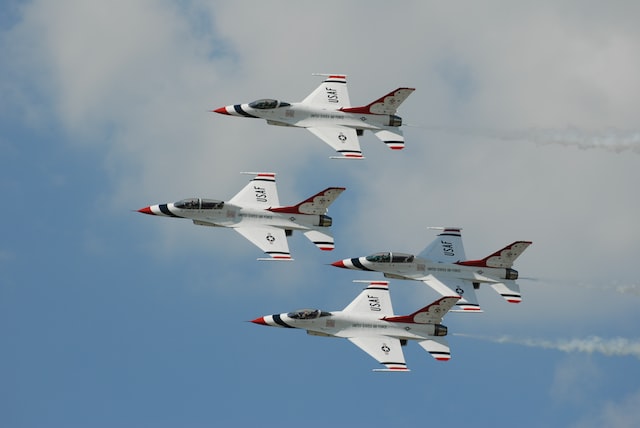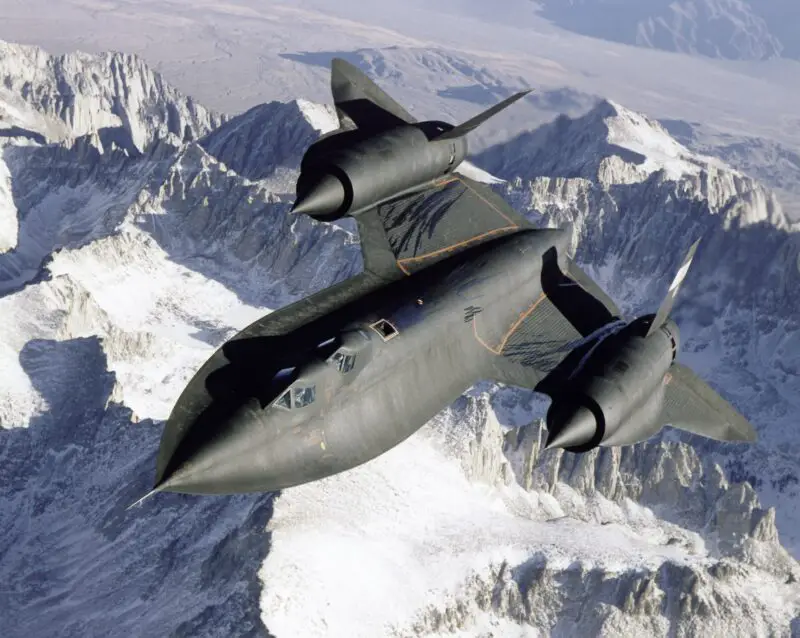The Air Force is a federal military branch, while the Air National Guard is a reserve component of the United States Air Force. The Air Force is responsible for the defense of the United States at home and abroad, while the Air National Guard focuses on providing support during domestic emergencies
Air Force
(Photo by Hans Dorries on Unsplash )

The Air Force is the branch of the military that is responsible for aerial warfare, it is overseen by the Department of Defense. The Air Force is a full-time force with active-duty personnel, It focuses more on international missions and strategic bombing. The Air Force is the branch of the military that is responsible for operating and maintaining the aircraft and equipment used by the other branches.
Air National Guard
The Air National Guard is a reserve force that can be called upon in times of need. The Air National Guard is part of the National Guard and falls under the jurisdiction of the state governor. Additionally, the Air National Guard has both full-time and part-time members. The Air National Guard often provides air support for ground troops and disaster relief efforts.
What’s the difference between the two?
The Air Force and the Air National Guard are two distinct branches of the United States military, both with their own missions, roles, and responsibilities.
The Air Force is a branch of the regular military, responsible for conducting operations and maintaining defense both domestically and abroad. The Air Force is part of the Department of Defense and operates under the jurisdiction of the Secretary of Defense.
On the other hand, the Air National Guard is a reserve component of the Air Force and is primarily responsible for providing support to local, state, and federal authorities in times of need, such as during natural disasters or civil unrest. The Air National Guard operates under the jurisdiction of the governor of each state and is only federalized, or brought under the control of the federal government, during times of national emergency.
Another key difference between the two is the deployment and employment. The Air Force can be deployed to various locations across the world, as directed by the President or the Secretary of Defense, and can be employed for extended periods of time. The Air National Guard, on the other hand, is usually only deployed within the United States, and its members are typically only employed for shorter, more localized missions.
Additionally, the training, education, and career opportunities also differ between the two branches. The Air Force offers extensive training and career advancement opportunities, with many active duty personnel pursuing advanced degrees and specialties within the military. The Air National Guard, as a reserve component, provides more limited training opportunities, but its members often have civilian careers and bring those skills and experiences back to their military roles.
One key difference between the two is that members of the Air Force are full-time soldiers, while members of the Air National Guard are part-time soldiers. This means that members of the Air Force are typically more highly trained than members of the Air National Guard.
Another difference between the two is that the Air Force is a federal entity, while the Air National Guard is controlled by individual states. This means that if you join the Air Force, you will be subject to deployment anywhere in the world. If you join the Air National Guard, you will only be deployed within your state unless your state governor requests assistance from other states.
The Air Force is responsible for the majority of the country’s air power. It is tasked with protecting the United States from air and space threats, and it also works to support ground troops. The Air National Guard, on the other hand, is a reserve force that can be called upon to provide support during emergencies or natural disasters. It also serves as a training ground for future Air Force pilots.
In short, the Air Force is a larger and more active force, while the Air National Guard is a smaller force that is mainly used for reserve and training purposes.
https://www.youtube.com/watch?v=_uOnGo2gET0&ab_channel=bigchhet
History of the Air Force
The history of the Air Force as a separate branch of the United States military can be traced back to the early 20th century, when the military began to recognize the potential of military aviation. In 1907, the Army established the Aeronautical Division, which was responsible for all military aviation operations. Over the next several decades, the role of military aviation continued to grow, and by the time of World War II, the United States had developed a powerful air force that played a critical role in the war effort.
After the end of World War II, the United States military underwent significant restructuring, and on September 18, 1947, the Air Force was established as a separate branch of the military under the National Security Act of 1947. The new Air Force was given responsibility for all military air operations, and it quickly established itself as a major military power with the development of advanced aircraft and missile systems.
Throughout the Cold War, the Air Force played a critical role in maintaining American military dominance, and it continued to evolve and adapt as new technologies emerged. During the Korean War, the Air Force demonstrated its ability to support ground troops and carry out strategic bombing missions, and during the Vietnam War, it played a major role in the American effort to defeat the communist forces in Southeast Asia.
In the decades since the end of the Cold War, the Air Force has continued to play a critical role in the defense of the United States and its allies. From Operation Desert Storm in the 1990s to the ongoing war against terrorism in the Middle East, the Air Force has proven to be a versatile and effective military branch, capable of carrying out a wide range of missions in support of American national security interests. Today, the Air Force is a highly advanced and technologically sophisticated military branch, with a proud history of service and sacrifice to the United States.
History of the Air National Guard
The Air National Guard has its roots in the militia system that was established by the founding fathers of the United States. Under this system, citizens were required to serve in the militia in times of national emergency, and the militia was seen as a critical component of national defense. Over time, the militia system evolved, and by the 20th century, many states had organized National Guard units that could be called up to serve in times of war or other national emergencies.
After the end of World War II, the National Guard underwent significant restructuring, and in 1947, the Air National Guard was established as a separate component of the National Guard. This new organization was designed to provide an organized military reserve that could be quickly mobilized in times of national emergency, and it quickly established itself as an important component of national defense.
Throughout the Cold War, the Air National Guard played a critical role in maintaining American military dominance, and it continued to evolve and adapt as new technologies emerged. During the Korean War, the Air National Guard provided critical support to the active-duty Air Force, and during the Vietnam War, it played a major role in the American effort to defeat the communist forces in Southeast Asia.
In the decades since the end of the Cold War, the Air National Guard has continued to play an important role in the defense of the United States and its allies. From responding to natural disasters at home to supporting overseas military operations, the Air National Guard has proven to be a versatile and effective military force, capable of carrying out a wide range of missions in support of American national security interests. Today, the Air National Guard is a highly advanced and technologically sophisticated military force, with a proud history of service and sacrifice to the United States.
What are the advantages and disadvantages of a career with the air force?
A career with the Air Force can offer many advantages and disadvantages, just like any other career. Here are some of the most notable:
Advantages:
- Opportunities for advancement: The Air Force provides opportunities for personnel to advance through the ranks, allowing them to take on higher-level responsibilities and command positions over time.
- Comprehensive benefits: Air Force personnel are eligible for a range of benefits, including competitive pay, health insurance, life insurance, and retirement benefits, as well as housing and education allowances for eligible personnel and their families.
- Career training and education: The Air Force provides extensive training and education opportunities, including specialized training in specific career fields and support for advanced degrees.
- Job security: With the Air Force being an essential component of the US military, jobs within the branch tend to be stable and secure, even in times of economic uncertainty.
- Sense of purpose and camaraderie: Many Air Force personnel report a strong sense of purpose and camaraderie within the branch, making it a supportive and rewarding work environment.
Disadvantages:
- Deployments and long periods of separation from family: Air Force personnel may be deployed to locations around the world, often for extended periods of time, resulting in long separations from family and loved ones.
- High stress and dangerous working conditions: The Air Force can be a high-stress and dangerous working environment, with personnel facing the potential for physical harm and exposure to traumatic experiences.
- Demanding work schedule: Air Force personnel often work long hours and irregular schedules, making it difficult to maintain a healthy work-life balance.
- Relocation: Air Force personnel may be required to move to different locations frequently, which can be disruptive to personal and family life.
- Strict rules and regulations: The Air Force has strict rules and regulations that must be followed, and personnel are subject to discipline for failing to comply with these standards.
It is important to weigh the advantages and disadvantages of a career in the Air Force and consider how it aligns with your personal goals, values, and priorities before making a decision.
What are the advantages and disadvantages of a career with the air national guard?
A career with the Air National Guard can offer many advantages and disadvantages, just like any other career. Here are some of the most notable:
Advantages:
- Part-time military service: Members of the Air National Guard serve on a part-time basis, typically one weekend a month and two weeks a year, allowing them to balance military service with other career or personal obligations.
- Opportunities for advancement: The Air National Guard provides opportunities for personnel to advance through the ranks, allowing them to take on higher-level responsibilities and command positions over time.
- Comprehensive benefits: Air National Guard personnel are eligible for a range of benefits, including competitive pay, health insurance, life insurance, and retirement benefits, as well as housing and education allowances for eligible personnel and their families.
- Career training and education: The Air National Guard provides extensive training and education opportunities, including specialized training in specific career fields and support for advanced degrees.
Sense of purpose and camaraderie: Many Air National Guard personnel report a strong sense of purpose and camaraderie within the branch, making it a supportive and rewarding work environment.
Disadvantages:
- Potential for deployments: Air National Guard personnel may be deployed to locations within the United States or abroad during times of national emergency or conflict.
- Part-time military service can impact other careers: The part-time nature of Air National Guard service can impact the ability to pursue other career opportunities or advance in a civilian job.
- Limited job security: While the Air National Guard provides job security, it is not as extensive as that offered by a full-time military career.
- High stress and dangerous working conditions: The Air National Guard can be a high-stress and dangerous working environment, with personnel facing the potential for physical harm and exposure to traumatic experiences.
- Demanding work schedule during deployments: Air National Guard personnel may be required to work long hours and irregular schedules during deployments, making it difficult to maintain a healthy work-life balance.









